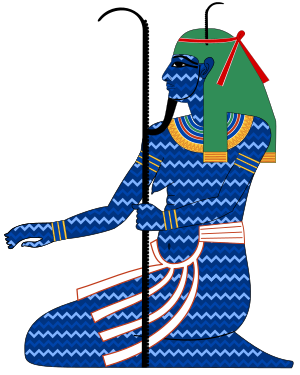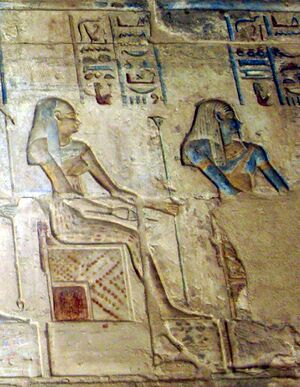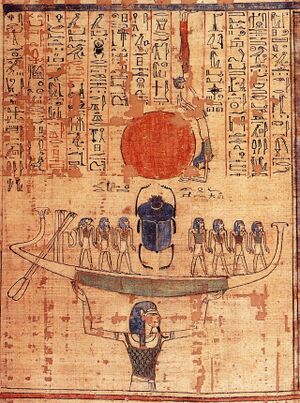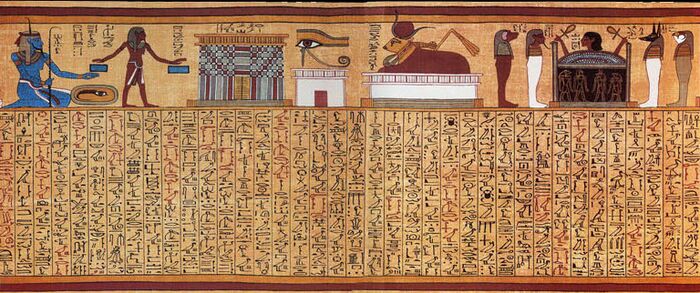نو (أسطورة مصرية)
| نو أو نون | |||||
|---|---|---|---|---|---|
 An aspect of Heh which personifies the endless waters of chaos. Based on the papyrus of Ani and New Kingdom tomb paintings. | |||||
| الاسم بالهيروغليفية |
| ||||
| مركز العبادة الرئيسي | ألفنتين | ||||
| الرمز | Water | ||||
| Naunet | ||||||
|---|---|---|---|---|---|---|
 Naunet and Nun | ||||||
| الاسم بالهيروغليفية |
| |||||
| القرين | Nu | |||||
نو أو نون Nu Nun (Ancient Egyptian: nnw Nānaw; Coptic: Ⲛⲟⲩⲛ Noun), in ancient Egyptian religion, is the personification of the primordial watery abyss which existed at the time of creation and from which the creator sun god Ra arose.[1]هو أحد الآلهة المصرية القديمة ، فهو أبو الآلهة ، الخضم الأزلي الذي انبثق منه كل شيء.
لقد كانت المياه الأزلية التي يجسدها الإله (نون Nun) موجودة دائما بالنسبة للمصريين فهي مع (الأخضر العظيم The Great Green) - كما كانوا يطلقون على البحار - كانت تحيط بالأرض التي تطفو على سطحها في شكل قرص مسطح . ويمتد (نون) تحت الأرض حيث نجده دوما إذا ما حفرنا على عمق تحت سطحها ، وما النيل إلا الإله (نون) نفسه خاصة مياه فيضانه التي تغمر مصر كل عام . وطبقا لاعتقاد قديم لم يتخيل عنه اللاهوت المصري قط فإن مياه هذا النهر كانت تتدفق مع مصدرين يقعان في منطقة الشلال الأول قرب مدينة (إلفنتين Elephantine) .[2]
Nu is one of the eight deities of the Ogdoad representing ancient Egyptian primordial Chaos from which the primordial mound arose. Nun can be seen as the first of all the gods and the creator of reality and personification of the cosmos. Nun is also considered the god that will destroy existence and return everything to the Nun whence it came. No cult was addressed to Nun.
Nun's consort (or his female aspect) was the goddess Nunut[3] or Naunet (Ancient Egyptian: nnwt).
Name
The name on Nu is paralleled with nen "inactivity" in a play of words in, "I raised them up from out of the watery mass [nu], out of inactivity [nen]". The name has also been compared to the Coptic noun "abyss; deep".[4]
Origin myth
|
جزء من سلسلة مقالات عن |

|
|
المعتقدات الرئيسية
وثنية • وحدة الوجود • تعدد الآلهة |
| الشعائر |
| صيغة التقديم • الجنائز • المعابد |
| الآلهة |
| أمون • أمونت • أنوبيس • أنوكت أپپ • أپيس • آتن • أتوم باستت • بات • بس أبناء حورس الأربعة گب • هاپي • حتحور • حقت حورس • إيزيس • خپري • خنوم خونسو • كوك • معحص • ماعت معفدت • منحيت • مرت سگر مسخنت • مونتو • مين • مر-ور موت • نون • نيت • نخبت نفتيس • نوت • اوزيريس • پاخت پتاح • رع • رع-حوراختي • رشپ ساتيس • سخمت • سكر • سركت سوبك • سوپدو • ست • سشات • شو تاورت • تفنوت • تحوت واجت • واج-ور • وپواوت • وسرت |
| النـصـوص |
| عمدوعت • كتاب التنفس كتاب المغارات • كتاب الموتى كتاب الأرض • كتاب الأبواب كتاب العالم السفلي |
| غيرهم |
| الآتونية • لعنة الفراعنة |
The ancient Egyptians envisaged the oceanic abyss of the Nun as surrounding a bubble in which the sphere of life is encapsulated, representing the deepest mystery of their cosmogony.[5] In ancient Egyptian creation accounts, the original mound of land comes forth from the waters of the Nun.[6] The Nun is the source of all that appears in a differentiated world, encompassing all aspects of divine and earthly existence. In the Ennead cosmogony, Nun is perceived as transcendent at the point of creation alongside Atum the creator god.[5]
أسطورة الخلق
 مقالة مفصلة: Ancient Egyptian creation myths
مقالة مفصلة: Ancient Egyptian creation myths
وفي اللاهوت الأشمونيني كانت مدينة الأشمونين ذاتها هي البقعة التي ظهر فيها التل الأزلي لأول مرة ، والذي يعني ظهوره من المحيط الأزلي اكتمال الخطوة الأولى نحو (بدء الخليقة)حيث ظهرت الملامح الأولي للحياة علي هذا التل الأزلي ، الذي ظهرت عليه كائنات- كالثعابين والضفادع – استمدت أسماءها (الليل والظلام والاختفاء والذبذبة ) من طبيعة المكان.
كذلك ظهرت علي التل الأزلي بيضة طائر مائي خرجت منها إوزة اُطلق عليها "الصائحة الكبرى" أحالت الظلام إلي نهار ، فأعتبرت بذلك الشمس التي طارت صائحة علي سطح الماء ، فكان ذلك هو الضوء الأول والصوت الأول الذي بدد الظلام. وبداية خلق الأرض باعتباره انبثاقا للأرض من الماء ، تبدو علي أنها فكرة وردت في أذهان وادي النيل بشكل طبيعي تلقائي ، حيث إنهم كانوا يشاهدون في بعض الأحيان جزراً من الطين تظهر في النيل.[7]
وعلى ذلك أضفى على هذه البقعة قداسة دائمة أحيط موقع بها بحائط مرتفع مستطيل الشكل كان داخله الموضع الذي يمثل مسرح الخليقة سميت (بحيرة السكينتين Lake of the Two Knives)والتي تمثل الإله نون أو المياه الأزلية التي تتوسطها (جزيرة اللهب) يعلوها تل ، واسم الجزيرة الأخيرة يعني بوضوح أن الضياء قط ظهر منها ، ومن التل الأزل الذي يرتفع فوقها . وفكرة المياه الأزلية وظهور تل أزلي منها يبدو أنها تولدت من ظاهرة الفيضان السنوي المنتظم للنيل الذي يغمر الأرض تدريجيا بمياهه في موسم الفيضان ، بيما تنحسر هذه المياه عند نهايته لتظهر أولا المناطق المرتفعة من الأرض تدريجيا .
وقد استبدلت نظرية نشأة الكون في "الأشمونيين" تاسوع عين شمس بثامون إلهي Ogdaad أو مجموعة مكونة من ثمانية آلهة ، هم: "نون Nun " ورفيقته "ناونتNaunt " و" حوح Huh " ورفيقته "حاوحت Hauhet " و"نون Nun " ورفيقته "ناونتNaunt " وكوك kuk" ورفيقته "كاوكت kauket " و"آمون Amon " ورفيقته "أماونت Amaunet ".
التاريخ
Beginning with the Middle Kingdom, Nun is described as "the father of the gods" and he is depicted on temple walls throughout the rest of ancient Egyptian religious history.[5]
The Ogdoad includes along with Naunet and Nun, Amaunet and Amun; Hauhet and Heh; and Kauket and Kek. Like the other Ogdoad deities, Nu did not have temples or any center of worship. Even so, Nu was sometimes represented by a sacred lake, or, as at Abydos, by an underground stream.[بحاجة لمصدر]
التصوير

Nun was depicted as an anthropomorphic large figure and a personification of the primordial waters,[1] with water ripples filling the body, holding a notched palm branch. Nun was also depicted in anthropomorphic form but with the head of a frog, and he was typically depicted in ancient Egyptian art holding aloft the solar barque or the sun disc. He may appear greeting the rising sun in the guise of a baboon. Nun is otherwise symbolized by the presence of a sacred cistern or lake as in the sanctuaries of الكرنك ودندرة.[بحاجة لمصدر]
Nu was shown usually as male but also had aspects that could be represented as female or male. Naunet (also spelt Nunet) is the female aspect, which is the name Nu with a female gender ending. The male aspect, Nun, is written with a male gender ending. As with the primordial concepts of the Ogdoad, Nu's male aspect was depicted as a frog, or a frog-headed man. In Ancient Egyptian art, Nun also appears as a bearded man, with blue-green skin, representing water. Naunet is represented as a snake or snake-headed woman.[بحاجة لمصدر]
In the 12th Hour of the Book of Gates, Nu is depicted with upraised arms holding a solar bark (or barque, a boat). The boat is occupied by eight deities with Khepri, Ra's morning aspect, standing in the middle and being surrounded by the seven other deities.[بحاجة لمصدر]
During the Late Period when Egypt was occupied by foreign powers, the negative aspect of Nun (ie. chaos) became the dominant perception, reflecting the forces of disorder that were set loose in the country.[5]
انظر أيضا
- Abzu
- Cosmic ocean
- Firmament
- Hapi
- بحر سوف – بحر أزلي في شكل الكون المندائي
- Tehom
- Vishnu
- Wadj-wer
- Wuji
المصادر
- ^ أ ب خطأ استشهاد: وسم
<ref>غير صحيح؛ لا نص تم توفيره للمراجع المسماةWilkinson-2003 - ^ ياروسلاف تشرني (1996). الديانة المصرية القديمة. دار الشروق للنشر.
{{cite book}}: Check date values in:|year=(help) - ^ Budge, E. A. Wallis (1920). An Egyptian Hieroglyphic Dictionary. J. Murray. p. 350.
- ^ Budge, E. A. Wallis (1904). The Gods of the Egyptians: Or, Studies in Egyptian Mythology. Vol. 1. Methuen & Company. p. 284.
- ^ أ ب ت ث McBride, Daniel R. (2003). The Oxford Essential Guide to Egyptian Mythology. Berkley. ISBN 0-425-19096-X.
- ^ Silverman, David P. (2003). Ancient Egypt. Oxford University Press. p. 120. ISBN 0-19-521952-X.
- ^ قصة الخلق والأساطير المصرية
- Short description is different from Wikidata
- Articles with hatnote templates targeting a nonexistent page
- Pages using infobox deity with unknown parameters
- Articles having same image on Wikidata and Wikipedia
- Articles having different image on Wikidata and Wikipedia
- مقالات ذات عبارات بحاجة لمصادر
- Chaos (cosmogony)
- آلهة مصرية
- Personifications
- Nubian gods
- Sea and river gods
- Water gods
- Solar gods
- إله مصري
- إله بحر ونهر
- آلهة بحر ونهر
- أساطير مصرية
- مفاهيم مصرية قديمة
